Delving into the wonders of the night sky is a truly enriching experience, and possessing one of the best amateur telescopes can unlock breathtaking views of distant celestial bodies. For anyone captivated by astronomy, from novice stargazers to seasoned enthusiasts, selecting the right telescope is a crucial first step. The market offers a vast array of options, varying in design, complexity, and price. This guide cuts through the jargon to help you find the ideal instrument tailored to your skill level, interests, and budget, ensuring your journey into the cosmos is as clear and captivating as possible. Our expert team has tested numerous models to bring you recommendations that truly perform.
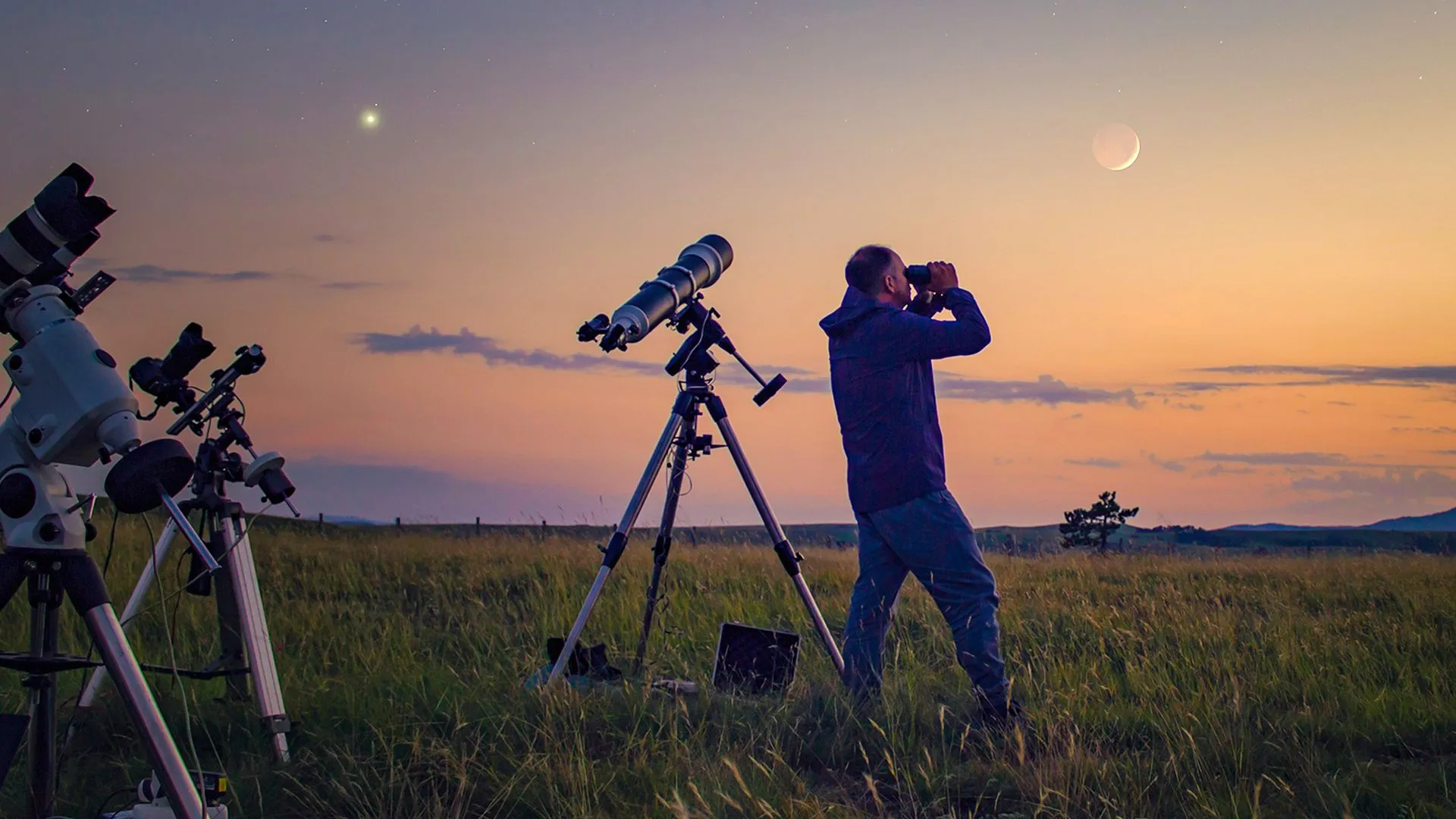
Man uses one of the best telescopes and binoculars to look at the night sky as the sun sets and telescopes are on tripods around him
The best telescopes offer up stunning views of the night sky. (Image credit: Getty)
May 2025 brings the spectacle of the Flower Moon on May 12, a sight enhanced when viewed through a quality instrument. As the month progresses and the full moon fades, the night sky presents opportunities to observe stars of varying colors – the blue-white brilliance of the Summer Triangle, the orange hue of Arcturus, and the reddish glow of Antares. For those keen on planets, a good telescope is essential to appreciate Saturn’s appearances before dawn this month, notably its proximity to the crescent moon on May 22. Choosing one of the best amateur telescopes reviewed here will significantly elevate these astronomical observations.
Our expert reviewers rigorously test each recommended model, assessing their observational capabilities, ease of use, and overall performance against manufacturer claims. This hands-on approach ensures our guide to the best amateur telescopes provides reliable and practical advice for your astronomical pursuits.
Top Recommended Amateur Telescopes for 2025
Why you can trust Space.com: Our expert reviewers spend hours testing and comparing products and services so you can choose the best for you. Find out more about how we test and review products.
Best for Beginners: Celestron NexStar 4SE
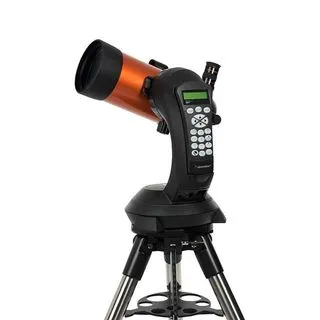
Celestron NexStar 4SE telescope on a white background
The Celestron NexStar 4SE is widely regarded as an excellent starting point for newcomers to astronomy, making it a strong contender for the title of best amateur telescope for beginners. Its intuitive design and automated features simplify the process of locating celestial objects.
What to Eat in Fort Worth – A Culinary Deep Dive
Discover the Top Restaurants in Denver – A Culinary Journey
Discover Where to Visit in Las Vegas
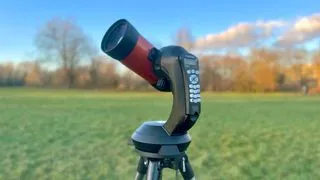
The celestron nexstar 4se set up outside in a fieldIn our full review of the Nexstar 4SE, we found it was quick and easy to set up, perfect for beginners who want a quality go-to telescope.(Image credit: Jonathan Lansley-Gordon)
In our detailed review of the NexStar 4SE, we found its setup process to be remarkably quick and easy, which is a significant advantage for beginners eager to start observing without lengthy preparations.
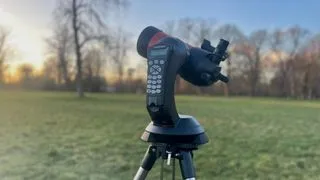
The celestron nexstar 4se set up outside in a field facing away from the cameraThe Celestron NexStar 4SE’s GoTo technology means you can easily find and track specific celestial objects.(Image credit: Jonathan Lansley-Gordon)
A key feature that positions this among the best amateur telescopes for ease of use is Celestron’s SkyAlign technology. By identifying just three bright objects in the night sky, the system calibrates itself, allowing you to automatically find and track numerous celestial targets with the push of a button, requiring little to no prior knowledge of constellations or object locations.
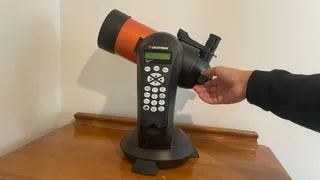
A view of the hand controller with author
Specifications
| Attributes | Notes |
|---|---|
| Optical design | Maksutov-Cassegrain |
| Mount type | Computerized Alt-Azimuth |
| Aperture | 4-inches / 102mm |
| Focal length | 1325mm |
| Highest useful magnification | 241x |
| Lowest useful magnification | 15x |
| Supplied eyepieces | 25mm |
| Weight | 23 lbs (10.44kg) fully assembled |
Reasons to buy
- Uncomplicated, quick setup
- Auto finds night sky objects
- High quality, sturdy build
- No collimation required
Reasons to avoid
- Narrow field of view
- Not very portable
- Limited accessories supplied
Buy it if:
✅ It’s your first telescope: This scope is easy to use and set up, making it perfect for beginner astronomers.
✅ You want GoTo technology: You can easily find and track specific celestial objects with little or no prior knowledge.
Don’t buy it if:
❌ You want to travel with it: This telescope isn’t the most portable as the tripod doesn’t fold down entirely.
The bottom line:
🔎 Celestron NexStar 4SE: If you want to view the planets and bright objects in the sky quickly and effortlessly, the Celestron NexStar 4SE will certainly do the job. ★★★★
With a 4-inch (102mm) aperture and a long focal length of 1,325mm, the NexStar 4SE delivers sharp views of planets and brighter sky objects. However, this combination results in a relatively narrow 1.2-degree field of view, making it challenging to frame larger deep-sky objects. It includes a 25mm Plossl eyepiece, but adding a 32mm eyepiece and a Barlow lens can significantly enhance your viewing range and utilize the 241x highest useful magnification more effectively.
The telescope features a durable build, contributing to its 23 lbs (10.4 kg) weight, which, along with a non-folding tripod, limits its portability compared to other models. Be aware that its computerized mount is power-hungry; using an external power source is highly recommended over the 8 AA batteries it requires. This makes the NexStar 4SE best suited for backyard stargazing rather than extensive travel.
Best Budget Option: Celestron Inspire 100AZ Refractor
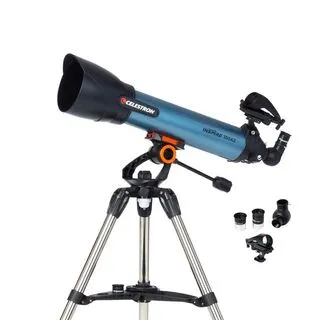 Celestron Inspire 100AZ telescope on a white background
Celestron Inspire 100AZ telescope on a white background
For those seeking an affordable entry point into the world of amateur astronomy without compromising too much on quality, the Celestron Inspire 100AZ Refractor stands out as a compelling option and could be considered the best amateur telescope in its budget class.
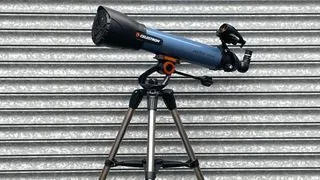 A side profile view of the telescope against a corrugated iron backdropThe Celestron Inspire 100AZ comes with a plethora of helpful accessories, but after our full review, we’d recommend updating the eyepieces.(Image credit: Jamie Carter)
A side profile view of the telescope against a corrugated iron backdropThe Celestron Inspire 100AZ comes with a plethora of helpful accessories, but after our full review, we’d recommend updating the eyepieces.(Image credit: Jamie Carter)
Our full review highlighted the Celestron Inspire 100AZ’s user-friendly nature and robust construction, making it an excellent choice for beginners. It’s also positioned at a competitive price point compared to many other telescopes available, solidifying its place as a top budget pick among the best amateur telescopes.
 A close-up of the focusing knob on the telescope tubeThis telescope is easy to set up and use, even for beginners.(Image credit: Jamie Carter)
A close-up of the focusing knob on the telescope tubeThis telescope is easy to set up and use, even for beginners.(Image credit: Jamie Carter)
As an achromatic refractor, the Inspire 100AZ features a 4-inch/100mm aperture and a focal length of 660mm. It’s mounted on a simple altazimuth setup, allowing movement side-to-side and up-and-down, controlled by a panhandle for precise positioning.
 A red flashlight that slots into the tripodA small red flashlight slots in to illuminate the accessory tray.(Image credit: Jamie Carter)
A red flashlight that slots into the tripodA small red flashlight slots in to illuminate the accessory tray.(Image credit: Jamie Carter)
The 100mm aperture is effective at gathering light, facilitating observations of fainter celestial objects like nebulas and galaxies. Its focal length also supports substantial magnification for detailed views of planets and the moon.
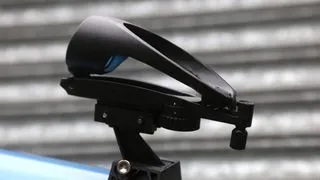 The finderscope attached to the telescopeA StarPointer Pro finderscope features a bullseye and sits close to the eyepiece.(Image credit: Jamie Carter)
The finderscope attached to the telescopeA StarPointer Pro finderscope features a bullseye and sits close to the eyepiece.(Image credit: Jamie Carter)
During our review, we noted some minor false color (chromatic aberration) visible as purple fringing around bright objects, and a slight blurring at the edges of the field of view. Upgrading the included eyepieces is recommended to maximize the telescope’s optical potential and mitigate some blurring. The false color is a common characteristic of achromatic refractors at this price point and is generally not a dealbreaker for most casual observers.
 The eyepiece and dust cap togetherA smartphone straps to one side using elasticated cords while an eyepiece fits in the other.(Image credit: Jamie Carter)
The eyepiece and dust cap togetherA smartphone straps to one side using elasticated cords while an eyepiece fits in the other.(Image credit: Jamie Carter)
The Inspire 100AZ comes with several accessories, including two eyepieces (20mm and 10mm), a red LED flashlight for preserving night vision, an accessory tray, and a StarPointer Pro finderscope. A particularly clever feature is the lens cap, which converts into a smartphone adapter, enabling easy astrophotography with your phone – a great feature for a budget-friendly best amateur telescope.
Specifications
| Attributes | Notes |
|---|---|
| Optical design | Refractor |
| Mount type | Alt-azimuth |
| Aperture | 3.94-inches / 100mm |
| Focal length | 660mm |
| Highest useful magnification | 241x |
| Lowest useful magnification | 15x |
| Supplied eyepieces | 10mm, 25mm |
| Weight | 20 lbs (9.07kg) |
Reasons to buy
- Sharp views of planets and the moon
- Handy smartphone adaptor
- Built-in red light
- Lightweight frame
Reasons to avoid
- Bearings lack precision
- Some chromatic aberration
- No solar observing possible
Buy it if:
✅ You’re a beginner: We found it easy to set up and take down, perfect for beginners.
✅ You want to take astro shots on your smartphone: The lens cap cleverly turns into a smartphone holder so you can capture images of the night sky.
Don’t buy it if:
❌ You aren’t confident locating objects yourself: This telescope doesn’t have GoTo technology, so you’ll need to be able to locate specific celestial objects yourself (or with the help of a stargazing app).
❌ You want detailed views of deep sky objects: While this telescope can give great views of planets and the moon, objects further away may appear a little underwhelming.
The bottom line:
🔎 Celestron Inspire 100az: Aimed at beginners and those looking to upgrade, this 4-inch refractor performs best with the moon and planets. It comes with a lens cap that converts to a smartphone holder for easy astrophotography. ★★★★
Best Value for Enthusiasts: Celestron Astro Fi 130 Newtonian Reflector
 The Celestron Astro Fi 130 on a white backgroundThe Celestron Astro Fi 130’s wide field of view will allow you to see large galaxies without having to reposition the telescope often. (Image credit: B&H Photo)
The Celestron Astro Fi 130 on a white backgroundThe Celestron Astro Fi 130’s wide field of view will allow you to see large galaxies without having to reposition the telescope often. (Image credit: B&H Photo)
Positioned as a top contender for the best amateur telescope offering excellent value to enthusiasts, the Celestron Astro Fi 130 combines advanced technology with an accessible price.
In our comprehensive review of the Celestron Astro Fi 130, we were highly impressed by its capabilities relative to its cost. It presents a strong case for being the best amateur telescope for those looking for advanced features without a premium price tag.
Specifications
| Attributes | Notes |
|---|---|
| Optical design | Newtonian Reflector |
| Mount type | Computerized altitude-azimuth single fork |
| Aperture | 5.19-inches / 130mm |
| Focal length | 650mm |
| Highest useful magnification | 307x |
| Lowest useful magnification | 19x |
| Supplied eyepieces | 25mm and 10mm |
| Weight | 18 lbs (8.6kg) |
Reasons to buy
- Suitable for low budgets
- Great entry-level telescope
- Vixen dovetail for mount changes
- Portable
- Computer recommends targets
- Finds targets at touch of button
Reasons to avoid
- Eyepieces limit observations
- Focuser of low quality
- Battery drains quickly
- Useless without app
Buy it if:
✅ You want a beginner-friendly, grab & go, easy-to-use telescope: We thought this was a great entry-level telescope that can find targets at the touch of a button and is great for on-the-go observations.
Don’t buy it if:
❌ You want a ‘traditional’ telescope: We found this telescope is completely useless without the app, so if you want a more traditional telescope without much of the newer technology, look elsewhere.
The bottom line:
🔎 Celestron Astro Fi 130: A good telescope at an exceptionally good price, it has everything you’d need if you’re just starting out, although we would recommend upgrading some of the pieces included. It can lose charge quickly in cold conditions, though, so consider buying an additional power source. ★★★½
This capable entry-level telescope features a Newtonian reflector design and a sturdy aluminum tripod. It comes equipped with 10mm and 25mm Kellner eyepieces, providing 65x and 26x magnification respectively, and a red dot finder. To truly unlock the Astro Fi 130’s potential, we highly recommend investing in better quality Plossl eyepieces. Our review also noted that battery life can be short in cold weather, suggesting rechargeable 12V batteries as a worthwhile addition.
This is among the best amateur telescopes for beginners due to its ease of use. The SkyAlign technology simplifies setup, removing the need for prior sky knowledge, while the Celestron SkyPortal app allows seamless control via smartphone or tablet. The app can even suggest interesting celestial objects and guide the motorized mount to them. The Astro Fi 130 provides good views of the moon, revealing details like craters and rilles. Venus and Mars are easily visible, and we were even able to catch a glimpse of the Andromeda Galaxy.
Best Premium Option: Celestron NexStar Evolution 9.25 Schmidt-Cassegrain
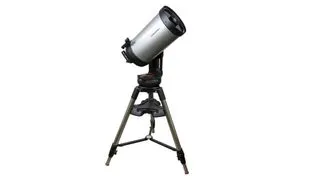 The Celestron NexStar Evolution 9.25 on a tripod on a white backgroundAutomatically track objects as they move across the sky with this high-quality Catadioptric telescope. (Image credit: B&H Photo)
The Celestron NexStar Evolution 9.25 on a tripod on a white backgroundAutomatically track objects as they move across the sky with this high-quality Catadioptric telescope. (Image credit: B&H Photo)
For experienced enthusiasts seeking top-tier performance, the Celestron NexStar Evolution 9.25 is arguably one of the best amateur telescopes available, delivering breathtaking views and premium features.
Our expert review found this GoTo scope to be truly exceptional. It provides crisp, high-definition views of the universe, justifying its position as a premium choice among the best amateur telescopes.
Specifications
| Attributes | Notes |
|---|---|
| Optical design | Schmidt-Cassegrain |
| Mount type | Computerized alt-azimuth fork arm |
| Aperture | 9.25-inches / 235mm |
| Focal length | 2350mm |
| Highest useful magnification | 555x |
| Lowest useful magnification | 34x |
| Supplied eyepieces | 13mm, 40mm |
| Weight | 62.60 lbs (28.39kg) |
Reasons to buy
- Crisp views with no defects
- Easy to set up
- High-quality design
Reasons to avoid
- Isn’t very portable — best for backyard star gazing
- Expensive
Buy it if:
✅ You want to view a wide range of subjects: This scope has a large aperture which enables clear and detailed views of a wide range of celestial objects, including planets, deep-sky objects and nebulas.
✅ You’re an experienced skywatcher: Although its easy setup is a dream for beginners, this scope is best suited for more advanced, passionate astronomers who want a full view of the universe.
Don’t buy it if:
❌ You want something portable: Portability isn’t one of the Evolution 9.25’s strengths, so it’s best used for backyard gazing.
The bottom line:
🔎 Celestron NexStar Evolution 9.25: A fantastic telescope best suited to experienced skywatchers, with a price tag to match its premium features. It’s not the easiest to transport, but we think it’s one of the best GoTo telescopes you can buy ★★★★½
This Schmidt-Cassegrain optical tube boasts a generous 235mm aperture, mounted on a robust single-fork arm for excellent stability. The motorized mount is powered by a rechargeable lithium-ion battery, offering an impressive 10 hours of observing time. The NexStar Evolution 9.25 includes useful accessories: a red dot finderscope, star diagonal, accessory tray, AC adapter, hand control, and two eyepieces (13mm and 40mm). While beginner-friendly in setup, its advanced features and performance make it ideal for seasoned skywatchers seeking one of the best amateur telescopes for detailed observations.
Astrophotographers will appreciate the motorized mount’s ability to track celestial objects. Control via the free Celestron SkyPortal app further enhances usability, freeing your hands during imaging sessions. Its substantial weight (62.60 lbs / 28.39kg) means it’s not the most portable, making it better suited for a fixed location like a backyard observatory, but its robust design and features easily compensate for this if portability isn’t a primary concern.
Best for Astrophotography: Celestron Origin Intelligent Home Observatory Smart Telescope
 a black and white telescope in a fieldThe Celestron Origin looks like a classic Celestron optical tube, minus an eyepiece.(Image credit: Future/Brett Tingley)
a black and white telescope in a fieldThe Celestron Origin looks like a classic Celestron optical tube, minus an eyepiece.(Image credit: Future/Brett Tingley)
Stepping into the future of capturing the night sky, the Celestron Origin Intelligent Home Observatory redefines what one of the best amateur telescopes can do for astrophotography, offering automated deep-sky imaging capabilities.
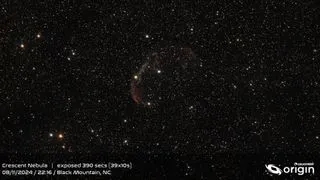 a black and white telescope in a field with trees behind itThe camera inside the Celestron Origin enables you to capture beautiful shots of the night sky. (Image credit: Future/Brett Tingley)
a black and white telescope in a field with trees behind itThe camera inside the Celestron Origin enables you to capture beautiful shots of the night sky. (Image credit: Future/Brett Tingley)
This smart telescope distinguishes itself by omitting a traditional eyepiece, relying instead on a built-in camera and a mobile device display. This setup allows you to view and image the night sky directly on your smartphone or tablet.
 a black and white telescope in a field with trees behind itThere are several handles on the Origin’s mount to make carrying it easier.(Image credit: Future/Brett Tingley)
a black and white telescope in a field with trees behind itThere are several handles on the Origin’s mount to make carrying it easier.(Image credit: Future/Brett Tingley)
The result is stunningly clear images of deep-sky objects and distant galaxies captured in mere seconds, effective even under light-polluted urban skies. In our review, we found that within moments of selecting an object in the app, the telescope produced sharp images of nebulas with minimal noise. The ‘snapshot’ mode offers manual control for single photos. However, we had less success imaging planets, suggesting a potential learning curve or limitation for planetary observation.
 a black and white telescope in a field with trees behind itThe Celestron Origin enabled us to view Saturn, although we struggled with focusing on planets.(Image credit: Future/Brett Tingley)
a black and white telescope in a field with trees behind itThe Celestron Origin enabled us to view Saturn, although we struggled with focusing on planets.(Image credit: Future/Brett Tingley)
Beginners will find this among the best amateur telescopes for ease of entry into astrophotography, thanks to its quick setup and automatic features like focusing and tracking. The intuitive Origin app simplifies image capture and navigation. The ‘Planetarium View’ shows a representation of the sky, allowing you to tap on objects to automatically point the telescope.
 a black and white telescope in a field with trees behind itAn example of a sharp astro shot taken without a filter with the Celestron Origin. The subject is the Crescent Nebula (NGC 6888).(Image credit: Future/Brett Tingley)
a black and white telescope in a field with trees behind itAn example of a sharp astro shot taken without a filter with the Celestron Origin. The subject is the Crescent Nebula (NGC 6888).(Image credit: Future/Brett Tingley)
While appearing like a standard telescope tube, the absence of an eyepiece and its weight (41.6 lbs / 18.6 kg) make it less portable. The nearly $4,000 price tag is a significant investment, but for dedicated astrophotographers seeking automation and rapid deep-sky results, it’s a highly recommended option for a smart best amateur telescope.
Specifications
| Attributes | Notes |
|---|---|
| Optical design | Rowe-Ackermann Schmidt Astrograph (RASA) |
| Mount type | Motorized Alt-azimuth |
| Aperture | 6-inches / 152mm |
| Focal length | 335mm |
| Highest useful magnification | N/A |
| Lowest useful magnification | N/A |
| Supplied eyepieces | N/A |
| Weight | 41.6 lbs (18.6 kg) |
Reasons to buy
- Crystal clear deep sky photos in seconds
- Quick set up
- Easy-to-use, helpful app
- Stacks and processes images automatically
Reasons to avoid
- Not ideal for all celestial objects
- Quite large and heavy
Buy it if:
✅ You want an automated telescope: Focusing, tracking, finding targets and stacking processed images is all automatic with this one.
✅ You want to take deep sky images: The Origin can do this and more in just a few minutes, with little pre-knowledge required.
Don’t buy it if:
❌ You want a traditional telescope: This one doesn’t have an eyepiece and only gives you views of the night sky on a mobile device.
❌ You’re on a budget: At around $4,000, this telescope is on the pricier side.
The bottom line:
🔎 Celestron Origin Intelligent Home Observatory: This (pricey) smart telescope can do every part of stargazing autonomously, and produces beautiful photos of the night sky in seconds. ★★★★½
Best Motorized Option: Celestron NexStar 8SE Schmidt-Cassegrain
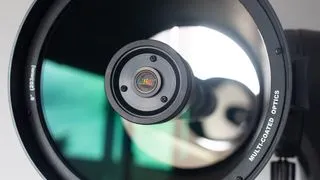 Celestron NexStar 8SE review photoThe clutter free sides make the 8SE easy to manouver without breaking any ‘bits’ off(Image credit: Jason Parnell-Brookes)
Celestron NexStar 8SE review photoThe clutter free sides make the 8SE easy to manouver without breaking any ‘bits’ off(Image credit: Jason Parnell-Brookes)
Dubbed ‘The World’s Most Beloved Telescope’, the Celestron NexStar 8SE is an exceptionally flexible and powerful instrument, making it a top contender for the best amateur telescope with a motorized mount, suitable for a wide range of users.
 Celestron NexStar 8SE review photoThe NexStar 8SE comes with a 25mm eyepiece. You’d probably want to invest in a 10mm eyepiece for a closer look at celestial objects(Image credit: Jason Parnell-Brookes)
Celestron NexStar 8SE review photoThe NexStar 8SE comes with a 25mm eyepiece. You’d probably want to invest in a 10mm eyepiece for a closer look at celestial objects(Image credit: Jason Parnell-Brookes)
Our review of the NexStar 8SE found it to be an ideal scope for learning and growing with, accommodating beginners with no prior sky knowledge while satisfying intermediate to advanced astronomers with its stunning optics. Its primary drawback is the price, but for those with the budget, it offers exceptional value for a best amateur telescope that can last decades.
 Celestron NexStar 8SE review photoAlthough the included NexStar 8SE finderscope looks very basic, it’s actually surprisingly effective.(Image credit: Jason Parnell-Brookes)
Celestron NexStar 8SE review photoAlthough the included NexStar 8SE finderscope looks very basic, it’s actually surprisingly effective.(Image credit: Jason Parnell-Brookes)
Using the Celestron SkyAlign app, you align the scope with three bright stars, after which the operation becomes automatic. The handheld remote allows you to select celestial objects, and the motorized mount smoothly slews the telescope to your target. Categories include ‘solar system’, ‘stars’, and ‘deep sky’, or you can opt for a ‘sky tour’ which automatically selects interesting objects based on your location.
 Celestron NexStar 8SE review photoThe focus knob is large. It can easily be found in the dark and can be operated when wearing gloves(Image credit: Jason Parnell-Brookes)
Celestron NexStar 8SE review photoThe focus knob is large. It can easily be found in the dark and can be operated when wearing gloves(Image credit: Jason Parnell-Brookes)
With an 8-inch aperture and Schmidt-Cassegrain design, the NexStar 8SE gathers a large amount of light, providing bright and clear views of objects within and beyond our solar system. Its catadioptric construction keeps the distinctive orange tube relatively short, enhancing its portability for seeking darker skies.
 Celestron NexStar 8SE review photoThe NexStar 8SE has a 203.2mm aperture lens which means you can observe deep-sky objects with breathtaking detail and vividness.(Image credit: Jason Parnell-Brookes)
Celestron NexStar 8SE review photoThe NexStar 8SE has a 203.2mm aperture lens which means you can observe deep-sky objects with breathtaking detail and vividness.(Image credit: Jason Parnell-Brookes)
We were particularly impressed by the smoothness and accuracy of the motorized fork arm in our review, making it a great option for long-exposure astrophotography. Be aware it requires 8 AA batteries, so rechargeable batteries are a cost-effective necessity for this power-hungry scope. Considering the scope’s capabilities and longevity, this investment is minor for a best amateur telescope of this caliber.
Specifications
| Attributes | Notes |
|---|---|
| Optical design | Schmidt-Cassegrain |
| Mount type | Computerized alt-azimuth fork arm |
| Aperture | 8-inches / 203mm |
| Focal length | 2032mm |
| Highest useful magnification | 480x |
| Lowest useful magnification | 29x |
| Supplied eyepieces | 25mm |
| Weight | 32 lbs (14.48kg) |
Reasons to buy
- Incredibly bright views
- Sharpness across the entire field of view
- Pricey, but good value for money
Reasons to avoid
- Will price some beginners out
- Slewing using the remote is a little laggy, but not much
Buy it if:
✅ You’re looking for a long-term telescope: There’s no question that this telescope is pricey, but it’s one that will last you for decades — it’s not called ‘The World’s Most Beloved Telescope’ for nothing.
✅ You want to use it for astrophotography: Thanks to the smooth and accurate tracking, this scope is a great option for taking stunning astro images of deep sky objects.
Don’t buy it if:
❌ You’re on a budget: Although this is definitely worth the money and we’d recommend it if your budget can stretch to it, it is very pricey. If you’re on a budget or you’re new to the medium, there are plenty of cheaper alternatives that will be more than good enough.
The bottom line:
🔎 Celestron NexStar 8SE: An outstanding telescope with incredible optics that would suit a beginner, intermediate or advanced astronomer. It’s great for astrophotography and gives beautifully bright and detailed views. Our only fault with it is that it can price out beginners. ★★★★½
Best for Portability: Celestron Astro Fi 102 Maksutov-Cassegrain
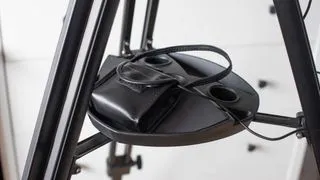 The Celestron Astro Fi 102The telescope may not be the most attractive, and some might even say it looks a little ‘toyish,’ but the optical quality is good.(Image credit: Jason Parnell-Brookes)
The Celestron Astro Fi 102The telescope may not be the most attractive, and some might even say it looks a little ‘toyish,’ but the optical quality is good.(Image credit: Jason Parnell-Brookes)
For stargazers on the go, especially those in urban areas needing to escape light pollution, the Celestron Astro Fi 102 stands out as the most portable GoTo option, making it a prime candidate for the best amateur telescope for travelers.
 The Celestron Astro Fi 102While this telescope is very portable, we found the finish doesn’t feel very premium.(Image credit: Jason Parnell-Brookes)
The Celestron Astro Fi 102While this telescope is very portable, we found the finish doesn’t feel very premium.(Image credit: Jason Parnell-Brookes)
The Celestron Astro Fi 102 offers several benefits for beginners: it’s relatively easy to set up, features a motorized mount for automatic target slewing, and is affordably priced for a Maksutov-Cassegrain scope. Its array of convenient features and accessories make it a great starter best amateur telescope.
 The Celestron Astro Fi 102The telescope comes with a 25 mm eyepiece and a 10mm eyepiece providing 53x and 132.5x magnification respectively.(Image credit: Jason Parnell-Brookes)
The Celestron Astro Fi 102The telescope comes with a 25 mm eyepiece and a 10mm eyepiece providing 53x and 132.5x magnification respectively.(Image credit: Jason Parnell-Brookes)
A standout feature in our review was its portability. Weighing only 6 lbs (2.7kg) with a compact body, it’s exceptionally easy to carry. However, caution is needed as it’s not as robust as pricier scopes and isn’t waterproof. The included tripod also felt somewhat flimsy and benefited from added weight for stability.
 The Celestron Astro Fi 102The finderscope is attached to the tube with ease.(Image credit: Jason Parnell-Brookes)
The Celestron Astro Fi 102The finderscope is attached to the tube with ease.(Image credit: Jason Parnell-Brookes)
Integrated WiFi allows pairing with the Celestron SkyPortal app, which boasts a database of around 100,000 celestial objects. Beginners can easily select a target, and the telescope will automatically slew to it, simplifying navigation.
 The Celestron Astro Fi 102The accessory tray is useful for keeping your gear nearby and tidy in the dark(Image credit: Jason Parnell-Brookes)
The Celestron Astro Fi 102The accessory tray is useful for keeping your gear nearby and tidy in the dark(Image credit: Jason Parnell-Brookes)
For its price, the Astro Fi 102 provides good views of the moon’s craters and closer planets like Mars, Saturn, and Jupiter. Under good conditions, Uranus or Neptune might also be visible. While there’s some sharpness drop-off at the edges, this is typical for scopes in this range; avoiding it requires a much more expensive model. The plastic casing, while acceptable, doesn’t feel premium and offers limited protection against bumps or moisture, unlike more durable, sealed telescopes. Despite these minor points, it remains a strong contender for a portable best amateur telescope.
Specifications
| Attributes | Notes |
|---|---|
| Optical design | Maksutov-Cassegrain |
| Mount type | Computerized Alt-Azimuth Single Fork Arm |
| Aperture | 4.0-inches / 102mm |
| Focal length | 1325mm |
| Highest useful magnification | Up to 100x with digital zoom |
| Lowest useful magnification | 15x |
| Supplied eyepieces | 25mm and 10mm |
| Weight | 6 lbs (2.7kg) |
Reasons to buy
- Very portable thanks to its lightweight design
- Reasonably and fairly priced
- No prior experience needed
Reasons to avoid
- Optics could be better
- Tripod isn’t the best quality
- Doesn’t feel like a premium product to the touch
Buy it if:
✅ You’ll be traveling with it: This scope is our top choice for portability, so it’s ideal if you plan on taking it away on camping trips or to areas with darker skies.
✅ You’re a beginner: If you just want to look at the moon and some planets, this is a great choice.
Don’t buy it if:
❌ You want good quality parts: This telescope has an element of ‘you get what you pay for’. It’s adequate for basic astronomy, but the tripod isn’t the best quality, the optics could be better and it didn’t have a premium feel.
The bottom line:
🔎 Celestron Astro Fi 102: Best suited for viewing the moon and planets, this telescope is great for beginners and anyone with no prior experience. It can be a little tricky to setup initially, and it’s not the best quality scope we’ve reviewed, but it’ll do the job. ★★★½
Best for Accessories: Sky-Watcher Skymax 150 PRO Maksutov-Cassegrain
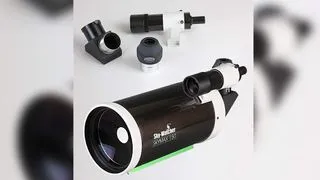 The Sky-Watcher Skymax 150 and accessories laid on a white tableThis scope is a great astrophotography all-rounder; you can capture everything from planets to deep-sky subjects. (Image credit: Amazon)
The Sky-Watcher Skymax 150 and accessories laid on a white tableThis scope is a great astrophotography all-rounder; you can capture everything from planets to deep-sky subjects. (Image credit: Amazon)
Designed with expandability in mind, the Sky-Watcher Skymax 150 PRO is a superb choice for the astrophotographer or observer who loves to customize their setup, making it potentially the best amateur telescope for accessory compatibility.
This Maksutov-Cassegrain telescope is particularly well-suited for astrophotographers due to its high-quality equatorial mount, supporting both short and long-exposure imaging. Its compatibility with numerous accessories sets it apart as a versatile best amateur telescope.
Specifications
| Attributes | Notes |
|---|---|
| Optical design | Maksutov-Cassegrain |
| Mount type | Equatorial (EQ-5 Pro) |
| Aperture | 5.90-inches / 150mm |
| Focal length | 1800mm |
| Highest useful magnification | 450x |
| Lowest useful magnification | 36x |
| Supplied eyepieces | 28 mm |
| Weight | 13.23 lbs (6kg) |
Reasons to buy
- High-quality, lightweight build
- Excellent optics
- Great for a wide selection of astrophotography
Reasons to avoid
- Not all models come with a tripod
- Comes with only one eyepiece
Buy it if:
✅ You want to travel with it: Most astrophotography involves traveling to dark sky sites, and this telescope is light enough to do just that.
✅ Your primary focus is astrophotography: We recommend this telescope as the best for astrophotography thanks to its amazing optics.
Don’t buy it if:
❌ You’re looking for something super sophisticated: For those looking for high-end, sophisticated instruments and have the money to spend on them, a smart telescope would likely be a better fit.
The bottom line:
🔎 Sky-Watcher Skymax 150 PRO: This telescope is perfect for astrophotographers who want to take it on shoots — it has great quality optics and an excellent build. It can accommodate plenty of accessories, although not all models come with a tripod. ★★★★
Weighing just 13.23 lbs (6kg), this telescope is easily portable for trips to dark-sky sites. It works well with various equatorial mounts and readily accommodates accessories like CCD or DSLR cameras, filter wheels, and other add-ons. A Vixen-style dovetail plate simplifies mount attachment. The well-built Mak-Cass telescope includes a 28mm eyepiece providing 64x magnification, yielding detailed views of celestial objects.
The Skymax 150’s optics are impressive, offering crisp, distortion-free views. It’s versatile, capturing images of planets, distant galaxies, and nebulas. Its user-friendly nature and ease of accessorizing make it a great choice for amateur astronomers and astrophotographers of all levels. We also found the Skymax 150 to be good value compared to some competitors, making it a strong contender for a customizable best amateur telescope. The smooth focuser maintains fine focus well, crucial for long astrophotography sessions.
Best Smart Telescope: Unistellar eQuinox 2 Smart Telescope
 Telescope in-use against night skyThe Unistellar eQuinox 2 can smoothly and silently slew to night sky objects and image them within minutes of getting it out of the box.(Image credit: Jason Parnell-Brookes)
Telescope in-use against night skyThe Unistellar eQuinox 2 can smoothly and silently slew to night sky objects and image them within minutes of getting it out of the box.(Image credit: Jason Parnell-Brookes)
Representing the cutting edge of astronomical technology, the Unistellar eQuinox 2 is a sophisticated smart telescope that simplifies observing, aiming to be the best amateur telescope experience driven by automation and app control.
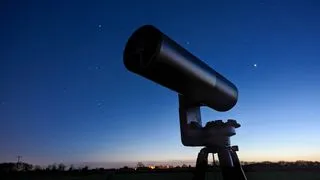 Telescope in-use against starry skyOnly a single button appears on the eQuinox 2 telescope, the power button which glows red when on and connected.(Image credit: Jason Parnell-Brookes)
Telescope in-use against starry skyOnly a single button appears on the eQuinox 2 telescope, the power button which glows red when on and connected.(Image credit: Jason Parnell-Brookes)
The Unistellar eQuinox 2 integrates the latest smart technology into a sleek, modern motorized reflector. Operated primarily via the intuitive Unistellar app, it features only a single power button on the mount. Unlike traditional telescopes, it requires no finderscope, eyepieces, or separate accessories.
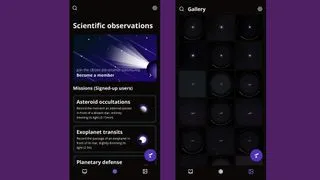 Screenshots of the Unistellar app in useAll of the functionality of this telescope can be accessed with the accompanying app(Image credit: Jason Parnell-Brookes)
Screenshots of the Unistellar app in useAll of the functionality of this telescope can be accessed with the accompanying app(Image credit: Jason Parnell-Brookes)
Equipped with a 6.2MP image sensor (an upgrade from the previous model), the telescope captures and stacks multiple images in real-time, creating the effect of a long exposure. This process makes objects appear brighter on your connected phone or tablet screen as the image builds. While this digital approach differs from traditional eyepiece viewing, it excels in urban environments thanks to its Smart Light Pollution Reduction feature, which effectively mitigates light pollution effects. The ability to easily save and share real-time images is another benefit.
In our review, the Autonomous Field Detection feature made setup quick and easy. The intuitive app then allows effortless navigation to celestial objects. The menu presents a selection of currently visible objects, or you can search its vast database of 37 million stars and over 5,000 celestial objects.
At around $2,000, this high-tech telescope is a significant investment. However, if your budget allows and you prioritize ease of use, light pollution mitigation, and automated digital observing/imaging, the Unistellar eQuinox 2 stands out as a leading contender for the best amateur telescope in the smart category.
Specifications
| Attributes | Notes |
|---|---|
| Optical design | Newtonian Reflector |
| Mount type | Motorized GoTo alt-azimuth |
| Aperture | 4.49-inches / 114mm |
| Focal length | 450mm |
| Highest useful magnification | 400x digital |
| Lowest useful magnification | 50x optical |
| Supplied eyepieces | N/A |
| Weight | 19.8 lbs (9kg) |
Reasons to buy
- Beautiful, simple layout and design
- Get views of the night sky fast
- App is easy to operate
Reasons to avoid
- Image resolution is average
- Can’t orientate telescope in twilight
- Laggy views when focusing
Buy it if:
✅ You live in an urban area: This scope has a Smart Light Pollution Reduction feature that removes light pollution, s it’s a great option if you don’t live near a dark sky site.
✅ You want simplicity: This is an incredibly sleek, all-in-one telescope that has no need for additional accessories and can take you to your chosen celestial objects with ease.
Don’t buy it if:
❌ You’re on a budget: Unsurprisingly, this is an expensive bit of kit, so it’ll price out most beginners and anyone who doesn’t have a big budget.
The bottom line:
🔎 Unistellar eQuinox 2: An easy-to-use motorized smart telescope that can locate night sky objects at the push of a button, the eQuinox 2 can have you exploring the stars in minutes without the need for prior knowledge, although its in-built camera isn’t quite detailed enough. ★★★★½
Best for Deep Space: Celestron Advanced VX 8 EdgeHD Schmidt-Cassegrain
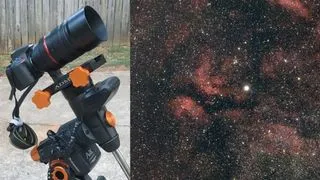 Review photo of the Celestron Advanced VX8 Edge HDThe Celestron Advanced VX8 comes packaged with Celestron’s imager focused Advanced VX mount.(Image credit: Future/Michael Covington)
Review photo of the Celestron Advanced VX8 Edge HDThe Celestron Advanced VX8 comes packaged with Celestron’s imager focused Advanced VX mount.(Image credit: Future/Michael Covington)
Aimed at serious amateur astronomers and astrophotographers, the Celestron Advanced VX 8 EdgeHD stands out for its exceptional optics and robust equatorial mount, making it arguably the best amateur telescope for exploring deep-sky objects with pinpoint sharpness.
 Review photo of the Celestron Advanced VX8 Edge HDComputerized mount finds celestial objects, taking commands from hand box or via USB from your PC.(Image credit: Future/Michael Covington)
Review photo of the Celestron Advanced VX8 Edge HDComputerized mount finds celestial objects, taking commands from hand box or via USB from your PC.(Image credit: Future/Michael Covington)
Celestron’s EdgeHD technology significantly enhances Schmidt-Cassegrain telescopes, particularly for astrophotography. Traditional Schmidt-Cassegrains can suffer from field curvature, blurring stars at the edges of images captured by flat-sensor cameras. EdgeHD corrects this, providing a perfectly flat field for sharp, detailed photos across the entire frame.
 Review photo of the Celestron Advanced VX8 Edge HDAn astrocamera (not included) or DSLR attaches in place of the eyepiece for photography through the telescope (Image credit: Future/Michael Covington)
Review photo of the Celestron Advanced VX8 Edge HDAn astrocamera (not included) or DSLR attaches in place of the eyepiece for photography through the telescope (Image credit: Future/Michael Covington)
Our review of the Advanced VX 8 EdgeHD confirmed that its optics successfully negate blurred edges, ensuring pinpoint sharpness. The optical performance is impressive, with crisp views free from distortion or false color, making it one of the best amateur telescopes for visual clarity.
 Review photo of the Celestron Advanced VX8 Edge HDAdvanced VX mount (older version shown, with aftermarket saddle) can carry camera and telephoto lens for dramatic deep-sky images (Image credit: Future/Michael Covington)
Review photo of the Celestron Advanced VX8 Edge HDAdvanced VX mount (older version shown, with aftermarket saddle) can carry camera and telephoto lens for dramatic deep-sky images (Image credit: Future/Michael Covington)
The Celestron Advanced VX 8 EdgeHD has a weight capacity of up to 30 lbs (13.6kg), providing stable support for the tube and accessories. It includes the standard NexStar+ hand controller, a 40mm eyepiece, and access to Celestron’s SkyPortal app and Starry Night Special Edition software. Packaged with Celestron’s imager-focused Advanced VX mount, it’s designed for astrophotography, capable of capturing images across the meridian without a “meridian flip.” The setup also features periodic error correction and an auto guider port.
Views of Saturn and Jupiter are dramatic; globular clusters resolve into individual stars; all Messier Objects are plainly visible. With dark skies and a trained eye, galaxies down to 12th magnitude can be seen. This is a telescope you won’t easily outgrow, solidifying its place as a top choice for the best amateur telescope for serious deep-sky exploration.
Specifications
| Attributes | Notes |
|---|---|
| Optical design | Schmidt-Cassegrain |
| Mount type | Motorized equatorial |
| Aperture | 8-inches / 203.2mm |
| Focal length | 2032mm |
| Highest useful magnification | 480x |
| Lowest useful magnification | 29x |
| Supplied eyepieces | 40mm |
| Weight | 61 lbs (27.67kg) |
Reasons to buy
- EdgeHD has the best optics available in a telescope of this size
- Computerized mount finds and tracks objects reliably
- Dovetail mount system
- Proven design on the market for years, incrementally refined
Reasons to avoid
- Setting up requires some knowledge of the sky
- Only one eyepiece is supplied
- Needs a sturdier mount for serious long-exposure photography
Buy it if:
✅ You want to see everything: While some telescopes are only good for seeing the moon and planets or deep space, this telescope is good for seeing all types of celestial objects.
✅ You want a seamless experience: We found the motorized mount on this telescope very smooth and slick.
Don’t buy it if:
❌ You’re a beginner: This telescope is intended for those with experience and knowledge of the sky and telescopes, so if you’re just starting out, we’d suggest a more beginner-friendly model.
❌ You want something lightweight: At 61 lbs (27.67kg), this telescope is heavier than most other choices in this guide.
The bottom line:
🔎 Celestron Advanced VX 8 EdgeHD: Intended for serious amateurs, this optically excellent telescope is suitable for all types of visual astronomy with its rugged, lightweight computerized mount. If you know the sky and plan to be doing astronomy for a long time, this is the telescope to get. ★★★★½
Best for Kids: Celestron FirstScope 76 Tabletop Telescope
 Celestron FirstScope on a white backgroundThe Celestron FirstScope is a low-budget tabletop instrument to instill some sky-watching enthusiasm into your children. (Image credit: Amazon)
Celestron FirstScope on a white backgroundThe Celestron FirstScope is a low-budget tabletop instrument to instill some sky-watching enthusiasm into your children. (Image credit: Amazon)
Designed as an entry-level instrument for young astronomers, the Celestron FirstScope 76 Tabletop telescope is portable, easy to use, and offers a great introduction to sky-watching, positioning it as the best amateur telescope specifically for children.
As its name implies, the Celestron FirstScope 76 is intended as a child’s initial telescope. Its ease of setup and use is a major plus; it arrives fully assembled, ready for immediate use – perfect for impatient young explorers.
Specifications
| Attributes | Notes |
|---|---|
| Optical design | Reflector |
| Mount type | Dobsonian |
| Aperture | 2.99-inch / 76mm |
| Focal length | 11.81-inch / 300mm |
| Highest useful magnification | 180x |
| Lowest useful magnification | 11x |
| Supplied eyepieces | 4mm, 20mm |
| Weight | 4.5 lbs / 2.04kg |
Reasons to buy
- Portable
- Easy to use
- Robust build
- Low investment for casual or young astronomers
- Fast focal ratio for easy observations of wide-angle targets
Reasons to avoid
- Loose focuser
- Some observations lack clarity and detail
- A challenge to collimate
- Finderscope not supplied
Buy it if:
✅ You want low investment: For casual viewing, this telescope is a great option with a low price point.
✅ You don’t want to spend ages setting it up: It arrives assembled and ready to go, so no complicated setup process needed.
Don’t buy it if:
❌ You want to find objects easily: It doesn’t come with a finderscope, so anyone wanting to locate certain celestial objects easily may get frustrated.
❌ You want all the extras: This package doesn’t include a finderscope, so you’ll need to either buy one separately or consider another telescope package that does.
The bottom line:
🔎 Celestron FirstScope 76 Tabletop Telescope: If you have children who have been bugging you for a telescope and you can’t quite commit to a moderately-priced instrument, then the FirstScope may be for you — especially if the moon and casual glances at the night sky are of interest. ★★★★
In our review, we noted its suitability for small hands, with the tube easily maneuvered to point at targets. It’s equipped with two basic eyepieces (4mm and 20mm) and features a 76mm aperture and a fast f/3.95 focal ratio, allowing views of brighter celestial objects and some fainter deep-sky targets. While not providing close-up, pin-sharp views, the crater views were impressive for a beginner scope. Its short base necessitates placement on a table for comfortable use.
The FirstScope 76 is highly portable at just 4.5 lbs (2.04kg). Despite its low price, the durable, non-glossy plastic build feels sturdy and premium. The main drawback is the absence of a finderscope, which aids in aiming. Adding an inexpensive red dot finder is highly recommended to improve the experience for young astronomers using this best amateur telescope for kids.
Telescope FAQ
Telescope FAQ answered by
Dr Gemma Lavender
How do I choose the right telescope for me?
Choosing the perfect telescope can be challenging, especially for beginners, due to technical jargon and numerous options. However, modern telescopes generally offer good quality. The key factors are optical quality, aperture size, portability requirements, and intended use (visual observing, astrophotography, etc.). Beginner telescopes are a great starting point. Consider your observing location (light pollution), what objects you wish to view, and whether you plan to use it for imaging. Portability is vital if you’ll travel to dark sky sites. Buy from reputable dealers who offer warranties and expert advice. Ultimately, the best amateur telescope for you depends on these personal criteria.
What types of telescope are there?
There are three main types: reflector, refractor, and catadioptric. Reflectors use mirrors, refractors use lenses, and catadioptrics use both. Each type has design variations. For best value per aperture, a Newtonian reflector on a simple undriven alt-azimuth mount (Dobsonian) is often recommended. Dobsonians are manual but gather significant light, offering breathtaking views, though larger models can be bulky. Adding an equatorial or computerized mount increases cost significantly. If ease of use, portability, and technology are priorities, a short focal length refractor or a catadioptric (Schmidt- or Maksutov-Cassegrain) on a computerized mount might be better.
These offer high magnification for detailed planetary and lunar views. Achromatic refractors are prone to false color but are affordable and low maintenance. Maksutovs minimize false color and coma. Apochromatic refractors offer superior, color-free views but are much more expensive. The choice of best amateur telescope type depends on your budget, viewing preferences, and willingness to handle setup complexity.
How does a refractor telescope work?
Refractors use lenses to bend (refract) light, focusing it to form an image that the eyepiece magnifies. They are generally easy to set up and maintain, making them popular for beginners focusing on planetary and lunar viewing. A main objective lens at one end and a star diagonal/eyepiece at the other form a straightforward design. Mounted on a simple alt-azimuth mount, they move side-to-side and up-and-down for target acquisition. While novice models are simpler and cheaper to manufacture, beware of low-quality refractors from non-specialized vendors. Refractors provide high-contrast, magnified images ideal for solar system targets. T
he best amateur telescope refractor for detail should have an aperture of 2 inches (60mm) or more; 3 to 4 inches (80-90mm) is better for larger apertures. A drawback is chromatic aberration (color fringing) around bright objects, as they struggle to focus all light wavelengths to one point. Achromatic and apochromatic (ED) designs reduce this. Achromatics are cheaper but may still show some fringing. Apochromatics use special glass for superior, color-free views but are significantly more expensive.
How does a reflector telescope work?
Reflector telescopes use mirrors to reflect light and create an image. The most common types are Newtonian and Dobsonian. A Newtonian uses a curved primary mirror at the base to collect light, reflecting it to a smaller secondary mirror near the front, which directs the light 45 degrees to the eyepiece. Newtonians are often on equatorial mounts, which track the sky’s rotation, making them versatile for observing and astrophotography. They offer more aperture for less money than refractors, providing greater value for a best amateur telescope. Newtonian mirrors require periodic alignment (collimation) and maintenance (cleaning/recoating).
A protective mirror coating is recommended. The Dobsonian is a type of Newtonian on a simple alt-azimuth mount, simplifying setup compared to equatorial mounts. Dobsonians are easy to use and manually point. Computerized or GoTo Dobsonians/Newtonians are available for automated object finding, though at higher cost. Reflectors excel at low-magnification views of deep-sky targets like galaxies and nebulas.
How does a catadioptric telescope work?
Catadioptric telescopes combine lenses and mirrors, taking advantage of both designs. They are often lightweight and portable, with sealed optics requiring little maintenance, making them a viable option for a best amateur telescope if budget allows (they are typically expensive). Light passes through a corrector lens (reducing aberrations like coma or false color) before hitting a primary mirror, which reflects it to a secondary mirror, then to the eyepiece. The two common types are Schmidt-Cassegrain and Maksutov-Cassegrain (Mak). Maksutovs are particularly good at correcting coma and chromatic aberration using a spherical mirror and a meniscus lens.
Their compact design and high magnification capability make them excellent for planets, the moon, and double stars. Many are available with GoTo systems. Schmidt-Cassegrains offer similar versatility, suitable for general observations and expandable fields of view with corrector lenses, making them flexible for various types of astronomical targets and a popular choice for a versatile best amateur telescope.
What is a finderscope?
A finderscope is a small, low-magnification telescope mounted parallel to your main telescope. Because the main telescope has a narrow field of view, a finderscope with a wider field helps you locate your desired object in the sky easily. You center the object in the finderscope’s view (often marked with crosshairs or a dot), and it will then be centered in your main telescope’s eyepiece. Many telescopes include a finderscope. There are two main types: straight-through and right-angled.
Right-angled finders are often used with Newtonian reflectors due to eyepiece placement, while straight-through is common for refractors and catadioptrics. Some finderscopes offer magnification. ‘Erect image’ finders use a prism to show the view right-side up and correctly oriented, while ‘inverted’ finders show a flipped image, which can be disorienting for beginners. Including or adding a finderscope significantly improves the usability of even the best amateur telescope.
What does aperture, magnification and focal length mean on a telescope?
- Aperture: The diameter of the main lens or primary mirror. Larger aperture collects more light, revealing fainter objects and finer details. A 200mm aperture collects four times the light of a 100mm, showing fainter stars and resolving smaller details like lunar craters or double stars, limited by optical quality and atmospheric conditions.
- Focal Length: The distance light travels from the objective lens/primary mirror to the focal point.
- Magnification: Calculated by dividing the telescope’s focal length by the eyepiece’s focal length. Higher magnification spreads light over a larger area, reducing brightness and making atmospheric turbulence more visible. Useful magnification depends on aperture and seeing conditions. A general guide is that the highest useful magnification is twice the aperture in millimeters (e.g., 200x for 100mm). The exit pupil (aperture / magnification) should ideally be 7mm or less to match a dark-adapted eye’s pupil, ensuring all gathered light is used for faint objects. The best amateur telescope setups include a range of eyepieces for low, medium, and high magnifications to suit different objects and conditions.
Magnification: How do telescope eyepieces work?
Eyepieces magnify the light focused by the telescope’s optics. Each eyepiece has a specific focal length; shorter focal lengths provide higher magnification. Magnification is calculated by dividing the telescope’s focal length by the eyepiece’s focal length. While any eyepiece can provide high magnification, increasing it too much reduces image brightness and quality, and exacerbates atmospheric turbulence. High magnification is most practical with driven mounts. For a versatile best amateur telescope, having at least three good quality eyepieces (e.g., Plossl type) for low (around 50x), medium (100x), and high (200x) magnifications is recommended. These different magnifications allow you to sweep wide areas to find objects, frame the moon or planets, and zoom in on details when seeing conditions are good.
Update Log
Recent updates
*Editor’s note 05/08/2025***:** Updated introduction to include details of the May 12 full moon, colorful stars in the night sky (Summer Triangle, Arcturus, Antares) and Saturn’s appearance.
How we test the best telescopes
To provide honest and informed recommendations for the best amateur telescope models, each unit undergoes thorough testing for observation performance. We evaluate the Optical Tube Assembly (OTA) design, including telescope type (refractor, reflector, catadioptric), component count, size, and lens clarity. This assessment considers maintenance needs like collimation and cleaning.
Telescope accessories, such as eyepieces and mounts, are assessed for functionality and quality. Motorized alt-azimuth and equatorial mounts are tested for smooth movement. Star alignment processes, from simple finder scope alignment to advanced laser collimation, are evaluated for ease and accuracy. We consider the level of astronomical knowledge required to operate each telescope effectively. Complex instruments may need regular collimation before each observation, which we note in our reviews. We also assess portability and suitability for travel to dark-sky sites, a key factor for many seeking the best amateur telescope.
The most critical aspect of testing is evaluating observational capabilities. We describe specific objects observed (moon, Jupiter, Messier objects) and honestly report image quality, checking for aberrations and distortions. Our testing verifies manufacturer claims against real-world use. Our staff and freelance reviewers are experienced stargazers, and we collaborate with astronomy experts to ensure accuracy and provide the most relevant information on telescope use.
